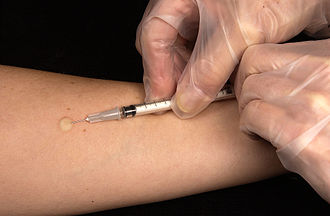Mantoux test
The Mantoux test is a widely utilized diagnostic tool for detecting infection by Mycobacterium tuberculosis, the bacterium responsible for tuberculosis (TB). It measures the body's immune response to a derivative of the bacterium, rather than the bacterium itself<ref>Stewart, RJ,
Mantoux test and its interpretation, Indian Dermatol Online J, 2011, Vol. 2(Issue: 1), pp. 2–6, DOI: 10.4103/2229-5178.79850, PMID: 22345773,</ref>.



Procedure[edit]
The test is administered by injecting a small amount of tuberculin purified protein derivative (PPD) into the dermis layer of the skin, usually on the inner forearm. The injection site is observed after 48-72 hours to determine the body's reaction to the tuberculin<ref>Menzies, D,
Interpretation of repeated tuberculin tests. Boosting, conversion, and reversion, American journal of respiratory and critical care medicine, 1999, Vol. 159(Issue: 1), pp. 15–21, DOI: 10.1164/ajrccm.159.1.9804054, PMID: 9872819,</ref>.
Interpretation[edit]
The key feature of the Mantoux test is the size of the induration (a hard, raised area), not the redness, at the injection site after 48-72 hours. The diameter of the induration is measured in millimeters. The interpretation of the test depends on the size of the induration and the patient's risk factors for tuberculosis<ref>
Guidelines for the investigation of contacts of persons with infectious tuberculosis(link). {{{website}}}. Centers for Disease Control and Prevention.
</ref>.
Limitations and False Results[edit]
The test does not differentiate between latent tuberculosis infection (LTBI) and active tuberculosis disease. It also does not distinguish between infection acquired recently and that acquired in the past. False-negative results may occur in individuals with impaired immune systems, while false-positive results can occur in those vaccinated with the BCG vaccine or infected with non-tuberculous mycobacteria<ref>Farhat, M,
False-positive tuberculin skin tests: what is the absolute effect of BCG and non-tuberculous mycobacteria?, The international journal of tuberculosis and lung disease, 2006, Vol. 10(Issue: 11), pp. 1192–1204, PMID: 17131765,</ref>.
Follow-up Testing[edit]
A positive Mantoux test indicates exposure to M. tuberculosis and warrants further investigation, such as a chest X-ray or sputum culture, to differentiate between latent infection and active disease.
See Also[edit]
References[edit]
<references />
Ad. Transform your life with W8MD's Budget GLP-1 injections from $75


W8MD offers a medical weight loss program to lose weight in Philadelphia. Our physician-supervised medical weight loss provides:
- Weight loss injections in NYC (generic and brand names):
- Zepbound / Mounjaro, Wegovy / Ozempic, Saxenda
- Most insurances accepted or discounted self-pay rates. We will obtain insurance prior authorizations if needed.
- Generic GLP1 weight loss injections from $75 for the starting dose.
- Also offer prescription weight loss medications including Phentermine, Qsymia, Diethylpropion, Contrave etc.
NYC weight loss doctor appointmentsNYC weight loss doctor appointments
Start your NYC weight loss journey today at our NYC medical weight loss and Philadelphia medical weight loss clinics.
- Call 718-946-5500 to lose weight in NYC or for medical weight loss in Philadelphia 215-676-2334.
- Tags:NYC medical weight loss, Philadelphia lose weight Zepbound NYC, Budget GLP1 weight loss injections, Wegovy Philadelphia, Wegovy NYC, Philadelphia medical weight loss, Brookly weight loss and Wegovy NYC
|
WikiMD's Wellness Encyclopedia |
| Let Food Be Thy Medicine Medicine Thy Food - Hippocrates |
Medical Disclaimer: WikiMD is not a substitute for professional medical advice. The information on WikiMD is provided as an information resource only, may be incorrect, outdated or misleading, and is not to be used or relied on for any diagnostic or treatment purposes. Please consult your health care provider before making any healthcare decisions or for guidance about a specific medical condition. WikiMD expressly disclaims responsibility, and shall have no liability, for any damages, loss, injury, or liability whatsoever suffered as a result of your reliance on the information contained in this site. By visiting this site you agree to the foregoing terms and conditions, which may from time to time be changed or supplemented by WikiMD. If you do not agree to the foregoing terms and conditions, you should not enter or use this site. See full disclaimer.
Credits:Most images are courtesy of Wikimedia commons, and templates, categories Wikipedia, licensed under CC BY SA or similar.
Translate this page: - East Asian
中文,
日本,
한국어,
South Asian
हिन्दी,
தமிழ்,
తెలుగు,
Urdu,
ಕನ್ನಡ,
Southeast Asian
Indonesian,
Vietnamese,
Thai,
မြန်မာဘာသာ,
বাংলা
European
español,
Deutsch,
français,
Greek,
português do Brasil,
polski,
română,
русский,
Nederlands,
norsk,
svenska,
suomi,
Italian
Middle Eastern & African
عربى,
Turkish,
Persian,
Hebrew,
Afrikaans,
isiZulu,
Kiswahili,
Other
Bulgarian,
Hungarian,
Czech,
Swedish,
മലയാളം,
मराठी,
ਪੰਜਾਬੀ,
ગુજરાતી,
Portuguese,
Ukrainian


